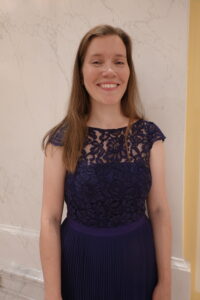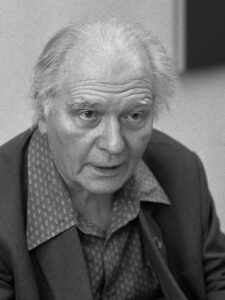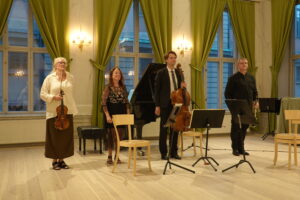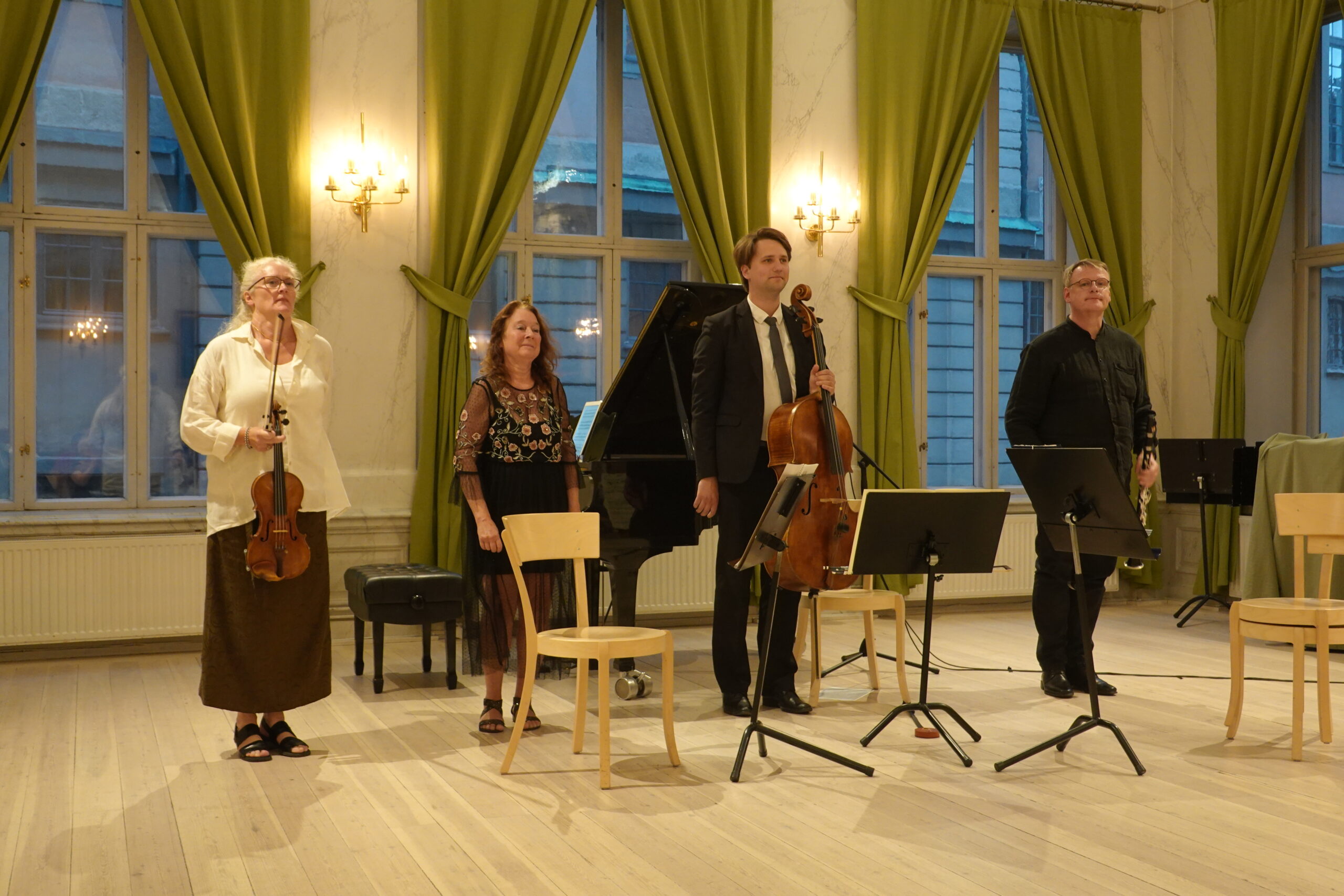I attended the Grande Finale of the Classical Chamber Music Festival in Stockholm on July 30. In attendance was a friend who drove from Tierp (some 80 miles north of Stockholm) for the concert. He found the trip well worthwhile, and his expert analysis of the concert is included here in quotes.
The programme featured three pieces: Thème et variations (Variations on a theme) by Olivier Messiaen, Frauenliebe und Leben by Robert Schumann, and another one by Messiaen, Quator pur la fin de temps (Quartet for the End of Time). This Quartet is now regarded as his masterpiece: it was composed while he was incarcerated by the Nazis in Stalag 8, and performed there in 1942.
“The reason for going was the last piece, and also that I know Stefan and Katarina, who are proud of their festival (The performers are listed at the conclusion). I find the Quartet for the End of Time to be an intriguing piece, and had reason to believe that this would be a good performance: the room is well suited for a piece like that (and an excellent chamber-music room, both acoustically, and in size, where a chamber-sized audience really get a close-up experience of the performance), and all four musicians are really fine chamber musicians.
“Walking upstairs, I was pleasantly surprised to find the room almost full; just a couple of chairs were still empty. (When I attended the Boulez concert earlier in the series, the room looked “corona secured” with empty chairs between seated listeners – probably just over half full.) Out of the available choices, I thought the one I chose in the second row would be at a suitable distance from the musicians, while still providing visibility (including the hands of the pianist).”
“The violin piece by Messiaen was new to me, possibly too new. I failed to find it interesting, although it was well played. Perhaps, on renewed listening, I would have found aspects to look for and enjoy. Tale has a very smooth and even way of playing; no rough edges, but also very little discernible temperament. Perhaps the score does not call for that. Tale also really excelled in soft playing, and I would have appreciated if Katarina would have followed that even more. Now, the piano was at times a bit too loud to really capture the magic in the extremely soft passages. (But that was perhaps a technical consideration on my part that you did not ask for.) I found your reflection regarding it as potential film music to be interesting, and can definitely see how a number of the movements could serve to complement filmed sequences. Another possibility would be to be enveloped by it if you are in a meditative mood.”
What struck me about the Variations by Messiaen was its suitability as a silent film soundtrack. Some years ago I saw The Phantom Carriage (1921) on television. My memory of this was jogged by seeing clips of it at a small theatre in Sweden’s National Museum. It is all about New Years’ Eve: the last person who dies before the stroke of midnight is in big trouble. His soul must then drive a wagon of the dead for the following year, travelling to the site of a person’s death to collect their souls. The second variation in this composition by Messiaen would been the perfect accompaniment to this horrific scene in the film.

“Next, the Schumann. Elisabeth Ljunggren presented it in a very personal manner, and then proceeded to perform it as if she was the young woman relating her own thoughts and emotions. I like her voice, and think that it works well in Lieder like these. The completely unforced high register, that she moves in and out of effortlessly, definitely contributes to an enjoyable listening experience. (There was a hint of a slightly “nervous” vibrato at times, but it was so slight that it did not materially impact the experience.) The names of the songs, and the parts of the text that I could catch, helped me follow the story from (astonished) love to frustrated resentment at the death of the beloved, but I realised that I should have brought up the sheet music on my smartphone, so I could really have been able to catch the nuances of the story. Schumann’s music, and Elisabeth’s rendering of the songs, certainly build on and illustrate the text. The piano part accompanies and emphasises the voice part in a truly Schumannesque manner, well performed by Katarina.”
This was the third time my friend had attended a performance of Quartet for the End of Time, whose title embodies its depiction of the Apocalypse. He wrote:

“Then, finally, the quartet. I thoroughly enjoyed it. The performance captured much of magic of the piece. The soft passages were really soft; the unison, rhythmic parts were really in unison; the contrasts between power or anguish and serenity were all there. The cello movement was really contemplative (and very competently played, not just technically, but also emotionally). The clarinet solo superbly utilises the expressive possibilities of the instrument, where the repeated swelling from barely audible to full power is absolutely amazing in Stefan’s rendering. The movements together span sentiments and present an interesting variation between contemplation, excitement, stillness and movement, sostenuto and rhythm, and do so in a progression where the serene end, performed by the violin, leaves you almost breathless. It does not in the least feel contrived when Tale lets her arm rest with the bow on the string and then, ever so gently, lifts it and lets it gently relax, not just preventing applause that would interrupt the magic, but also make the silence a part of the listening experience.”
The Quartet consists of 8 parts, including an Intermediate section separating the first 3 from the final 4 parts. The clarinet solo was an excellent showcase for that instrument, and while it consisted of seemingly random notes (not melodic) it gave Harg the opportunity to deliver a virtuoso performance. The solos for violin and cello, by contrast, were in a clearly classical framework. The cello solo built up with ever more intense, monotonous, sounds from the piano that seemed to presage a horrific event. A murder perhaps. Then it switches register abruptly to a much calmer conclusion.
A duet of the cello and violin reminded me of a walk through a strange and forbidding land, with the piano marking it step by step. At the other end of the spectrum was the “danse de la fureur,” a ferocious dance number engaging the full power of all four instruments.
“Walking back to the car through a warm summer-evening Stockholm, full of people enjoying the weather, and then driving back up north, into the sunset and the growing dusk, I was filled by the somewhat elated feeling that a truly enjoyable music experience can produce.”
Performers:
Elisabeth Ljunggren (mezzosoprano), Tale Olsson (violin), Erik Uusijarvi (cello), Katarina Strom-Harg (piano), Stefan Harg (clarinet)
For more about the festival, visit the website: www.classicalchambermusicstockholm.se
Photo of Messiaen is by Rob C. Croes (1986); photos of the July 30 performance are by C. Cunningham

